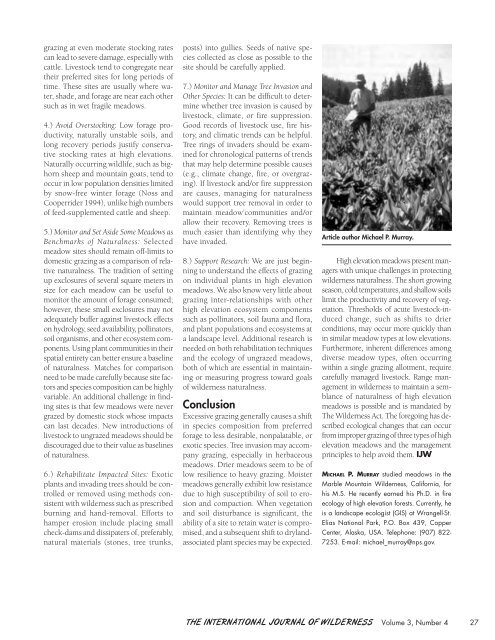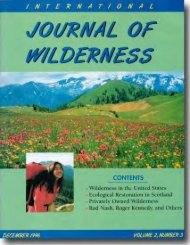Download full PDF - International Journal of Wilderness
Download full PDF - International Journal of Wilderness
Download full PDF - International Journal of Wilderness
You also want an ePaper? Increase the reach of your titles
YUMPU automatically turns print PDFs into web optimized ePapers that Google loves.
grazing at even moderate stocking rates<br />
can lead to severe damage, especially with<br />
cattle. Livestock tend to congregate near<br />
their preferred sites for long periods <strong>of</strong><br />
time. These sites are usually where water,<br />
shade, and forage are near each other<br />
such as in wet fragile meadows.<br />
4.) Avoid Overstocking: Low forage productivity,<br />
naturally unstable soils, and<br />
long recovery periods justify conservative<br />
stocking rates at high elevations.<br />
Naturally occurring wildlife, such as bighorn<br />
sheep and mountain goats, tend to<br />
occur in low population densities limited<br />
by snow-free winter forage (Noss and<br />
Cooperrider 1994), unlike high numbers<br />
<strong>of</strong> feed-supplemented cattle and sheep.<br />
5.) Monitor and Set Aside Some Meadows as<br />
Benchmarks <strong>of</strong> Naturalness: Selected<br />
meadow sites should remain <strong>of</strong>f-limits to<br />
domestic grazing as a comparison <strong>of</strong> relative<br />
naturalness. The tradition <strong>of</strong> setting<br />
up exclosures <strong>of</strong> several square meters in<br />
size for each meadow can be useful to<br />
monitor the amount <strong>of</strong> forage consumed;<br />
however, these small exclosures may not<br />
adequately buffer against livestock effects<br />
on hydrology, seed availability, pollinators,<br />
soil organisms, and other ecosystem components.<br />
Using plant communities in their<br />
spatial entirety can better ensure a baseline<br />
<strong>of</strong> naturalness. Matches for comparison<br />
need to be made care<strong>full</strong>y because site factors<br />
and species composition can be highly<br />
variable. An additional challenge in finding<br />
sites is that few meadows were never<br />
grazed by domestic stock whose impacts<br />
can last decades. New introductions <strong>of</strong><br />
livestock to ungrazed meadows should be<br />
discouraged due to their value as baselines<br />
<strong>of</strong> naturalness.<br />
6.) Rehabilitate Impacted Sites: Exotic<br />
plants and invading trees should be controlled<br />
or removed using methods consistent<br />
with wilderness such as prescribed<br />
burning and hand-removal. Efforts to<br />
hamper erosion include placing small<br />
check-dams and dissipaters <strong>of</strong>, preferably,<br />
natural materials (stones, tree trunks,<br />
posts) into gullies. Seeds <strong>of</strong> native species<br />
collected as close as possible to the<br />
site should be care<strong>full</strong>y applied.<br />
7.) Monitor and Manage Tree Invasion and<br />
Other Species: It can be difficult to determine<br />
whether tree invasion is caused by<br />
livestock, climate, or fire suppression.<br />
Good records <strong>of</strong> livestock use, fire history,<br />
and climatic trends can be helpful.<br />
Tree rings <strong>of</strong> invaders should be examined<br />
for chronological patterns <strong>of</strong> trends<br />
that may help determine possible causes<br />
(e.g., climate change, fire, or overgrazing).<br />
If livestock and/or fire suppression<br />
are causes, managing for naturalness<br />
would support tree removal in order to<br />
maintain meadow’communities and/or<br />
allow their recovery. Removing trees is<br />
much easier than identifying why they<br />
have invaded.<br />
8.) Support Research: We are just beginning<br />
to understand the effects <strong>of</strong> grazing<br />
on individual plants in high elevation<br />
meadows. We also know very little about<br />
grazing inter-relationships with other<br />
high elevation ecosystem components<br />
such as pollinators, soil fauna and flora,<br />
and plant populations and ecosystems at<br />
a landscape level. Additional research is<br />
needed on both rehabilitation techniques<br />
and the ecology <strong>of</strong> ungrazed meadows,<br />
both <strong>of</strong> which are essential in maintaining<br />
or measuring progress toward goals<br />
<strong>of</strong> wilderness naturalness.<br />
Conclusion<br />
Excessive grazing generally causes a shift<br />
in species composition from preferred<br />
forage to less desirable, nonpalatable, or<br />
exotic species. Tree invasion may accompany<br />
grazing, especially in herbaceous<br />
meadows. Drier meadows seem to be <strong>of</strong><br />
low resilience to heavy grazing. Moister<br />
meadows generally exhibit low resistance<br />
due to high susceptibility <strong>of</strong> soil to erosion<br />
and compaction. When vegetation<br />
and soil disturbance is significant, the<br />
ability <strong>of</strong> a site to retain water is compromised,<br />
and a subsequent shift to drylandassociated<br />
plant species may be expected.<br />
Article author Michael P. Murray.<br />
High elevation meadows present managers<br />
with unique challenges in protecting<br />
wilderness naturalness. The short growing<br />
season, cold temperatures, and shallow soils<br />
limit the productivity and recovery <strong>of</strong> vegetation.<br />
Thresholds <strong>of</strong> acute livestock-induced<br />
change, such as shifts to drier<br />
conditions, may occur more quickly than<br />
in similar meadow types at low elevations.<br />
Furthermore, inherent differences among<br />
diverse meadow types, <strong>of</strong>ten occurring<br />
within a single grazing allotment, require<br />
care<strong>full</strong>y managed livestock. Range management<br />
in wilderness to maintain a semblance<br />
<strong>of</strong> naturalness <strong>of</strong> high elevation<br />
meadows is possible and is mandated by<br />
The <strong>Wilderness</strong> Act. The foregoing has described<br />
ecological changes that can occur<br />
from improper grazing <strong>of</strong> three types <strong>of</strong> high<br />
elevation meadows and the management<br />
principles to help avoid them. IJW<br />
MICHAEL P. MURRAY studied meadows in the<br />
Marble Mountain <strong>Wilderness</strong>, California, for<br />
his M.S. He recently earned his Ph.D. in fire<br />
ecology <strong>of</strong> high elevation forests. Currently, he<br />
is a landscape ecologist (GIS) at Wrangell-St.<br />
Elias National Park, P.O. Box 439, Copper<br />
Center, Alaska, USA. Telephone: (907) 822-<br />
7253. E-mail: michael_murray@nps.gov.<br />
THE INTERNATIONAL JOURNAL OF WILDERNESS Volume 3, Number 4 27










